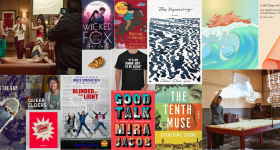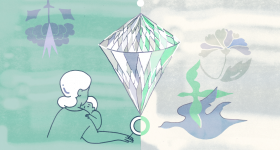The Way to Bea by Kat Yeh (Little, Brown and Company; Sept. 19, 2017) is a middle grade novel narrated by Beatrix Lee, the first-ever seventh-grader to be poetry editor of her school paper, Broadside. Bea recently started middle school under the shadow of estrangement from her best-friend-since-kindergarten and their other friends. Bea’s story includes mystery and adventure and a wonderful dose of coming-of-age, but what makes the book different is how it opens a window into the creative life.
Bea lives and breathes poetry, and as a reader it’s fun to experience the creative process through her. She says “all poems begin the same way: from something you feel inside,” but it’s not just people and events that can stir her feelings. Words delight her. For example, Bea enjoys the phrase drawing conclusions: “I like that conclusions can be drawn. And they’re something you need to figure out. So it sounds sort of like you can figure things out with art.” In class, when her teacher talks about the solution to a perfect maze, Bea thinks, “A perfect maze. It sounds like something that should be in a poem.” She closes her eyes and writes in the air with her finger as she imagines the form such a poem would take. Creative impulses are not always easy to live with, though: “I open my eyes to giggling in the room … I shove my hands deep into my pockets, where I plan to keep them for the rest of the year.”
Bea’s parents are artists, too, and the creative life has its challenges when it intersects with parenthood. When Bea gets home from school, she wonders what she’ll see through the windows of their backyard studio: “Will it be the back of my mom, holding her shoulders in a way that means she should not be interrupted?” Instead, she finds her mom “smiling and glowy” after apparently staying out in the studio painting all night. When they hug, Bea reports, “I … hold on, wondering how much time I have.” Her father is a popular graphic novel author/illustrator. Bea says, “There are these people who want to make Dad’s book into a movie, so he has been traveling a lot lately. It’s so, so exciting, but I feel as if I barely get to see him at all.” Her dad had asked Bea and her mom what superpower he should give his newest protagonist. He went with her mom’s idea, and Bea doesn’t blame him: “I couldn’t decide what to say, and I didn’t want to choose wrong and have them think their daughter didn’t get the creativity gene. And Dad was so in love with Mom for her answer and they had started kissing and laughing so much that I just left.” Bea’s parents trust and care about her; they love each other, and they love their work. Yet Bea feels neglected and left out, and worries about living up to their expectations.
Feeling lonely at home compounds Bea’s biggest problem — missing her old friends as she transitions into middle school. What Bea wants more than anything is for her friendship with Sammie to get back to normal. As narrator, Bea hesitates to reveal what happened with the friends she initially identifies only as S and L and L and A. Bea refuses to speak in class, but it becomes clear that being quiet is a departure for her. Sammie has told her she can be “too much;” Bea has taken this to heart and is trying to be “as anonymous as possible.” She used to write free verse poetry, painting it all over her bedroom walls; now she writes haiku on tiny notepapers in invisible ink, hiding the notes in a hole in a wall she and Sammie discovered years ago.
As part of her attempt to contain her personality, Bea avoids beginning her poetry editor tenure. Mrs. Reegs, school librarian and newspaper advisor, finally shepherds Bea into the Broadside office, a warm, inviting, creative space. She likes the other students she meets there and starts to make new friends. Briggs, an eighth-grader and the editor-in-chief, is “probably one of the nicest people you’ll ever meet,” according to Mrs. Reegs, and he already knows and appreciates Bea’s poetry. Jaime also seems nice, and like Bea, Jaime loves listening to music and wears headphones all the time. A boy named Will, who eats lunch in the Broadside office every day and has a particular way of talking and behaving, intrigues Bea the most. Will likes lists, information, routines and plans. He observes everything but is often overlooked himself. Bea decides to earn Will’s friendship. After a while, she finds a list he has made with bullet points of her likes and habits, and she realizes he is working hard to be her friend, too.
Will is obsessed with labyrinths in general and with the mysterious private labyrinth on the nearby Leland estate in particular. Will’s greatest wish is to walk the Leland Labyrinth, and Bea decides to help him do it. This external goal provides the aforementioned adventure and drives the second half of the book. The enterprise involves security guards named Brandon, bicycles and backpacks, “killer” hounds and hot chocolate. The plan goes awry when Bea gets a flat tire on the way to meet Will at the labyrinth, but she calls Briggs for help, and he gets her to the estate. The quest becomes downright confusing once the sun sets over the hedge maze and the only light is from matches and burning notepaper, but Bea faces her fears and learns more about her friends during the experience.
Bea’s internal goal is right there in the book’s title. She needs to find her “way to be”: Will she change to fit in, or simply be herself? When Bea asks Will why he won’t adjust his schedule to walk home with her, he asks, “Do you change for other people?” Bea considers the stakes after going to her hiding place and finding a reply to her invisible ink poetry: “ … how do you keep someone and make sure they don’t leave? How do you figure out how to be and how to act, so they don’t even want to begin to think about leaving?” She answers her secret correspondent with another question, in the form of a poem:
if I act
the way
I wish I were
am I still acting
— or becoming?
The resolution of Bea’s disconnect with her parents is not wholly convincing, especially considering the resolution involves the family welcoming a new member, and potential jealousy of the new baby is not explored at all. In every other area, however, whether regarding the main theme of choosing how to be, or one of the related questions like how to face fear or be a friend, Yeh delivers an ending worthy of her thoughtful main character. After she writes about acting versus becoming, Bea herself hints at the ending, noting that the poem is “not a haiku. But I like it … I think my friend will like it, too. I mean, people who are your friends are supposed to like things that are you, aren’t they?”










Comments